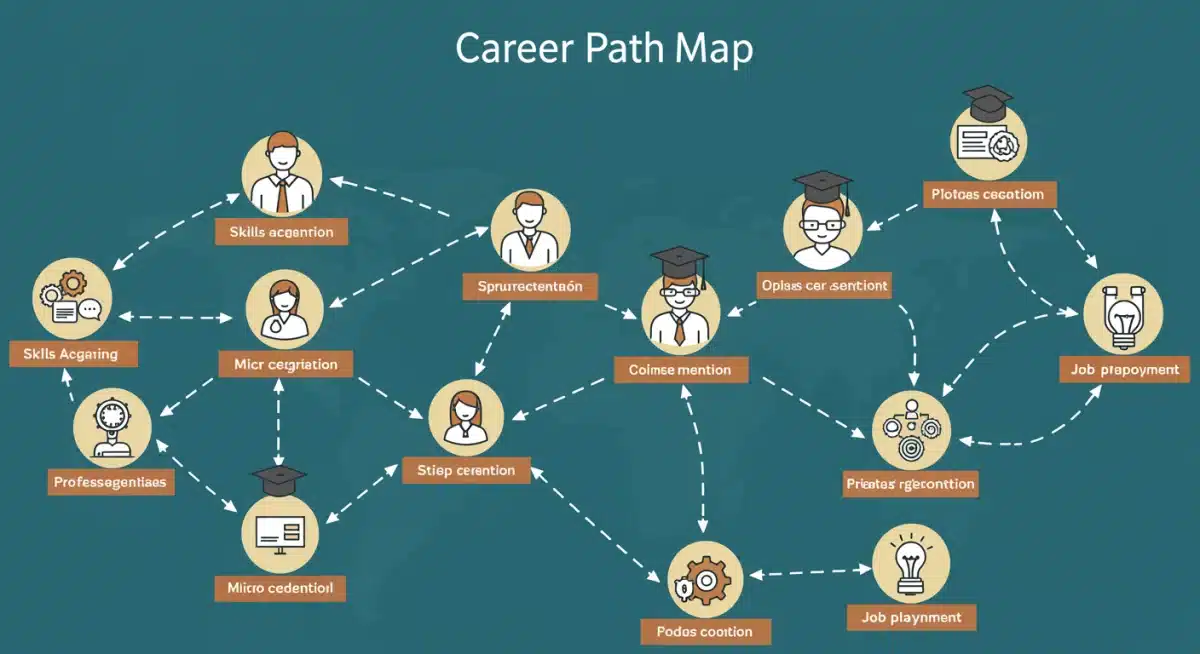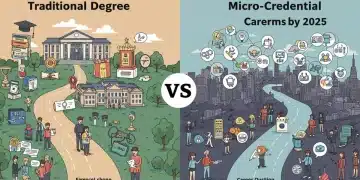Micro-Credentials: Boosting U.S. Employability by 20% by 2025

U.S. higher education institutions are actively developing strategies to integrate micro-credentials by 2025, a critical move projected to increase student employability by 20% by aligning learning with evolving industry demands and skill gaps.
The Future of Micro-Credentials: How U.S. Higher Education Institutions Can Implement New Models by 2025 to Increase Student Employability by 20% is rapidly becoming a focal point for educators, policymakers, and industry leaders across the United States. This transformative shift, driven by the need for a more agile and responsive workforce, promises to redefine how skills are acquired, recognized, and valued. New models are emerging, emphasizing practical application and direct relevance to current job market needs, with the ambitious goal of significantly boosting graduate employability within the next two years.
The Imperative for Micro-Credentials in U.S. Higher Education
The traditional four-year degree, while foundational, often struggles to keep pace with the rapid technological advancements and shifting skill requirements of the modern economy. Employers increasingly seek specific, verifiable competencies rather than broad academic qualifications alone. This growing disparity between academic offerings and workforce demands has created an urgent need for more flexible, targeted educational pathways.
Micro-credentials offer a compelling solution. These short, focused learning experiences, resulting in a certification of specific skills or competencies, bridge the gap between education and employment. They provide learners with opportunities to acquire in-demand skills quickly, update existing knowledge, or reskill for new career paths without committing to lengthy degree programs. For higher education institutions, embracing micro-credentials is not merely an option but a strategic imperative to remain relevant and competitive in a dynamic educational landscape.
Addressing Skill Gaps and Workforce Demands
- Rapid Skill Acquisition: Micro-credentials allow learners to gain specific, job-ready skills in a shorter timeframe compared to traditional degrees, making them ideal for upskilling or reskilling initiatives.
- Industry Alignment: Programs can be co-designed with industry partners, ensuring the content directly addresses current and future workforce needs, enhancing relevance and immediate applicability.
- Flexibility and Accessibility: Often delivered online or in blended formats, micro-credentials offer greater flexibility, making education accessible to working professionals, adult learners, and those in remote areas.
By focusing on discrete, verifiable competencies, micro-credentials enable institutions to respond more nimbly to economic shifts. This responsiveness is crucial for maintaining a competitive national workforce and ensuring that graduates possess the abilities employers are actively seeking. The move towards these credentialing models represents a significant evolution in how U.S. higher education can serve both students and the economy effectively.
Current Landscape and Emerging Models by 2025
Several U.S. higher education institutions have already begun piloting micro-credential programs, with significant expansion anticipated by 2025. These early adopters are demonstrating diverse models, ranging from stackable credentials that build towards full degrees to standalone badges validating niche skills. The common thread is a commitment to outcomes-based learning and transparent skill validation.
Research from organizations like the American Council on Education (ACE) and the Lumina Foundation highlights a growing acceptance of micro-credentials among employers. This acceptance is driven by the clarity these credentials offer regarding a candidate’s specific capabilities. By 2025, a more standardized, yet flexible, framework for micro-credential development and recognition is expected to solidify, fostering greater interoperability between institutions and industries.
Key Implementation Models Taking Shape
- Stackable Pathways: Institutions are designing sequences of micro-credentials that can be accumulated to earn a larger certificate or even contribute credits towards an associate’s or bachelor’s degree. This provides clear progression for learners.
- Employer-Integrated Programs: Partnerships with corporations and industry consortia are leading to the creation of bespoke micro-credentials tailored to specific company or sector needs, often involving direct input from employers on curriculum development.
- Digital Badges and Blockchain: The use of digital badges, often secured on blockchain technology, ensures authenticity and portability of credentials, making them easily shareable and verifiable by employers.
The evolving landscape indicates a move away from a one-size-fits-all education model towards a more personalized, skills-focused approach. This shift is not without its challenges, including ensuring quality assurance, establishing clear recognition pathways, and integrating these new models into existing academic structures. However, the potential benefits for student employability and institutional relevance are compelling enough to drive this rapid adoption.
Challenges and Solutions in Micro-Credential Implementation
While the promise of micro-credentials is significant, their widespread adoption and impact are contingent on addressing several critical challenges. These include issues of standardization, quality assurance, employer recognition, and equitable access. Without careful consideration and strategic solutions, the full potential of these new models to increase student employability may not be realized.
One primary concern revolves around the proliferation of diverse micro-credentials without a unified framework. This can lead to confusion for both learners and employers regarding the value and transferability of these credentials. Institutions must collaborate to establish common standards and articulate clear pathways for how micro-credentials can be recognized and stacked.
Overcoming Key Obstacles
- Standardization and Portability: Developing common taxonomies for skills and competencies, along with interoperable platforms for credential issuance and verification, is crucial for widespread acceptance. Initiatives like the Open Skills Network are working to address this.
- Quality Assurance and Rigor: Establishing robust processes for curriculum development, assessment, and faculty training ensures that micro-credentials maintain academic integrity and deliver genuine value to learners and employers.
- Employer Engagement: Actively involving employers in the design and validation of micro-credentials is vital to ensure their relevance and to foster broad industry recognition, directly impacting employability.
Addressing these challenges requires a concerted effort from higher education institutions, government bodies, industry associations, and technology providers. Collaborative initiatives, transparent communication, and a focus on learner outcomes will be essential to build trust and ensure that micro-credentials become a truly transformative force in U.S. education and workforce development.
Strategic Partnerships for Enhanced Employability
The success of micro-credentials in boosting student employability by 20% by 2025 heavily relies on the formation of robust strategic partnerships. These collaborations must extend beyond traditional academic alliances to include industry leaders, technology providers, and government agencies. Such partnerships are instrumental in ensuring that micro-credential programs are not only academically sound but also directly aligned with the dynamic needs of the job market.
Industry collaboration, in particular, is non-negotiable. Employers possess invaluable insights into the specific skills gaps and emerging competencies required in their sectors. By co-designing curricula, providing real-world projects, and offering internships or apprenticeships, industry partners can directly shape micro-credential offerings, making graduates more immediately employable. Furthermore, these partnerships can facilitate direct hiring pipelines, significantly shortening the transition from learning to employment.

Leveraging Collaborative Ecosystems
- Industry-Academia Consortia: Establishing formal consortia where universities and employers jointly identify skill needs, develop curriculum, and certify competencies ensures programs are market-driven and recognized.
- Government Funding and Policy Support: Federal and state initiatives can provide critical funding for program development, pilot projects, and research into the effectiveness and scalability of micro-credential models. Policies that encourage employer-university collaboration are also vital.
- Technology Platform Integration: Partnering with ed-tech companies can provide institutions with scalable platforms for content delivery, assessment, and the secure issuance of digital credentials, enhancing the learner experience and administrative efficiency.
These strategic alliances create a symbiotic ecosystem where educational institutions gain market relevance, industries secure a skilled talent pipeline, and students benefit from highly targeted, career-focused learning experiences. The collective impact of these partnerships will be a key determinant in achieving the ambitious goal of increased employability through micro-credentials.
Measuring Impact: Quantifying Employability Gains
To truly understand the success of micro-credential implementation, U.S. higher education institutions must establish rigorous methods for measuring their impact on student employability. The ambitious target of a 20% increase by 2025 necessitates clear metrics, consistent data collection, and transparent reporting. This goes beyond simple completion rates, focusing instead on tangible career outcomes.
Key performance indicators (KPIs) should include employment rates post-credential completion, salary increases, career advancement, and employer satisfaction. Tracking these metrics will not only demonstrate the value of micro-credentials but also provide crucial feedback for continuous program improvement. Without robust measurement, it becomes challenging to justify investments, refine offerings, and convince skeptical stakeholders of the efficacy of these new educational models.
Essential Metrics for Success
- Post-Completion Employment Rates: Tracking the percentage of micro-credential earners who secure employment in their target field within a specific timeframe (e.g., 3-6 months).
- Wage Premium/Salary Growth: Analyzing the salary increases experienced by individuals who acquire micro-credentials, particularly when compared to those without similar targeted training.
- Career Advancement and Mobility: Documenting promotions, new responsibilities, or successful transitions into new roles that can be directly attributed to the skills gained through micro-credentials.
- Employer Feedback and Satisfaction: Regularly surveying employers about the preparedness and performance of individuals holding specific micro-credentials, providing qualitative and quantitative insights.
Institutions should leverage data analytics and collaborate with workforce development agencies to gather comprehensive data. By focusing on measurable outcomes, U.S. higher education can unequivocally demonstrate how micro-credentials are contributing to a more skilled, adaptable, and employed workforce, thereby solidifying their role in the future of education.
Policy and Funding Mechanisms for Micro-Credentials
Effective implementation of micro-credentials and their projected impact on employability requires supportive policy frameworks and sustainable funding mechanisms. While institutions are innovating, governmental support at both federal and state levels can significantly accelerate adoption, ensure equity, and provide the necessary resources for developing high-quality programs. Without clear policy guidance and financial backing, scaling these initiatives across the diverse U.S. higher education landscape will prove challenging.
Policymakers can play a crucial role by recognizing micro-credentials as legitimate educational achievements, facilitating their integration into existing financial aid structures, and promoting cross-institutional transferability. Funding initiatives can support faculty training, technology infrastructure, and the development of robust assessment tools. Furthermore, policies that incentivize employer engagement and investment in micro-credential programs can create a powerful ecosystem for workforce development.
Key Policy and Funding Considerations
- Financial Aid Eligibility: Expanding federal financial aid eligibility (e.g., Pell Grants) to include high-quality, short-term micro-credential programs would significantly increase access for diverse learner populations.
- State-Level Initiatives: States can establish dedicated funding streams for universities and community colleges to develop and scale micro-credential offerings, particularly those aligned with critical state workforce needs.
- Employer Incentives: Creating tax incentives or grants for employers who invest in upskilling their workforce through micro-credentials, or who partner with educational institutions, can stimulate demand and collaboration.
The synergy between progressive policy, strategic funding, and institutional innovation is essential for realizing the full potential of micro-credentials. By 2025, a clearer, more comprehensive policy landscape is anticipated to emerge, fostering a supportive environment for these transformative educational models and ensuring they contribute meaningfully to increasing student employability.
Key Aspect |
Brief Description > |
|---|---|
Goal by 2025 |
Increase U.S. student employability by 20% through new micro-credential models. |
Core Challenge |
Aligning higher education offerings with rapid workforce skill demands. |
Key Strategy |
Strategic partnerships with industry, government, and tech providers. |
Measurement Focus |
Tracking employment rates, salary growth, and career advancement post-credential. |
Frequently Asked Questions About Micro-Credentials and Employability
Micro-credentials are short, focused certifications verifying specific skills or competencies. Unlike broad degrees, they target niche skills, are quicker to obtain, and are designed to meet immediate workforce demands, offering flexibility for learners to upskill or reskill.
Institutions are responding to a growing demand for job-ready skills and the rapid evolution of the job market. Micro-credentials help bridge skill gaps, enhance graduate employability, and ensure educational offerings remain relevant and competitive in a dynamic economy.
By providing targeted, verifiable skills directly sought by employers, micro-credentials make graduates more attractive candidates. Strategic partnerships with industry, standardized recognition, and flexible learning pathways will collectively contribute to this employability boost.
Key challenges include standardizing credential recognition, ensuring quality assurance across diverse programs, fostering widespread employer acceptance, and developing equitable access mechanisms. Collaborative efforts are crucial for addressing these hurdles effectively.
Strategic partnerships with industry, government, and technology providers are vital. They ensure curriculum relevance, facilitate direct hiring pipelines, provide necessary funding, and support policy frameworks, all critical for the widespread success and impact of micro-credentials.
Looking Ahead: The Evolving Role of U.S. Higher Education
The push for micro-credentials signifies a profound evolution in U.S. higher education, moving towards a more demand-driven, skills-focused paradigm. While the 2025 target for a 20% increase in student employability is ambitious, the current momentum, backed by institutional innovation, growing employer interest, and emerging policy discussions, suggests a significant shift is underway. The success of these new models will redefine the value proposition of higher education, emphasizing continuous learning and demonstrable competencies as cornerstones of career readiness. Stakeholders across the educational and economic spectrum will continue to monitor how these changes reshape the talent pipeline and contribute to a more resilient and adaptable workforce in the years to come.





